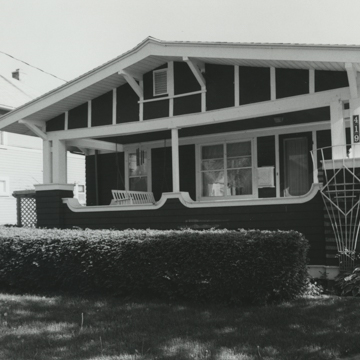Between 1908 and 1940, as many as a hundred thousand Americans purchased new homes through Sears, Roebuck and Company’s special catalogs, such as Book of Modern Homes and Building Plans (1908). The company offered 450 models over the years. Sears shipped ready-to-assemble kits, and most buyers hired contractors to erect their Sears houses. Architect William Bossman and his wife Carrie chose a popular Craftsman bungalow design, called the Osborn. One story tall, covered in wooden shingles and sheltered by a cross-gabled roof, the Osborn features a full-width front porch and a smaller, screened porch to one side. The roof has an exaggerated peak at its gable apex, false half-timbering, jigsaw-cut bargeboards, exposed rafter tails, and prominent braces. The Sears plan called for stucco cladding on the porch, but Bossman, who, unlike most Sears customers, supervised the construction of his own house, chose to use wooden shingle cladding, matching the walls. An Osborn with a stuccoed porch survives in Fond du Lac (N5758 Main Street).
You are here
William and Carrie Bossman House
If SAH Archipedia has been useful to you, please consider supporting it.
SAH Archipedia tells the story of the United States through its buildings, landscapes, and cities. This freely available resource empowers the public with authoritative knowledge that deepens their understanding and appreciation of the built environment. But the Society of Architectural Historians, which created SAH Archipedia with University of Virginia Press, needs your support to maintain the high-caliber research, writing, photography, cartography, editing, design, and programming that make SAH Archipedia a trusted online resource available to all who value the history of place, heritage tourism, and learning.















